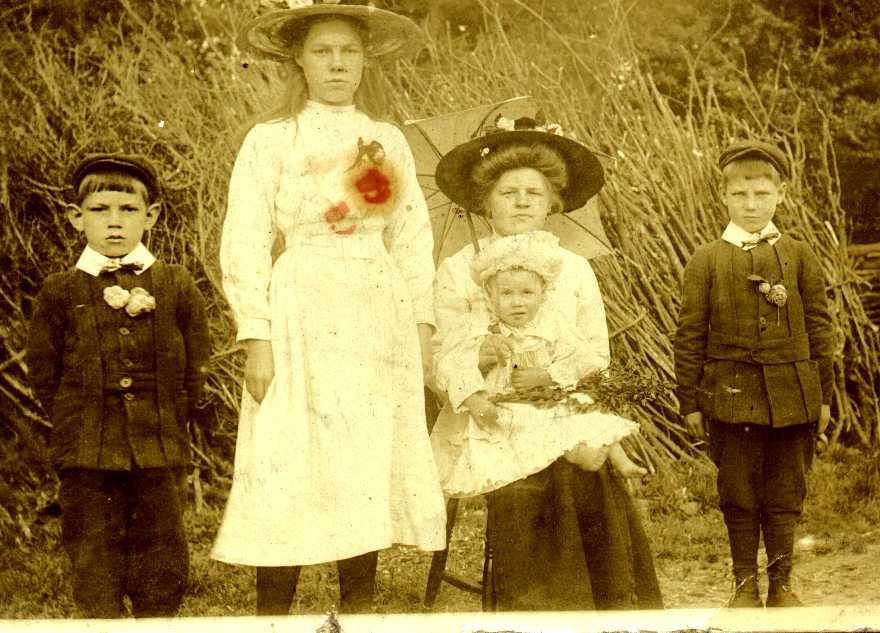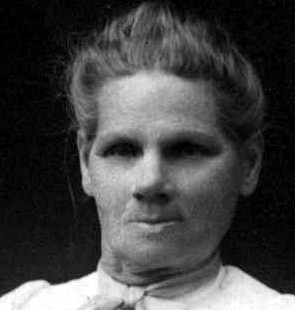| We often had difficulty in getting our horses and wagons across the flooded streams, Often my cloths were wet when I took them off at night and still damp when I put them on in the morning. Most farm work was Manuel. Artificial Fertilisers weren't used. Cow urine was put in tanks and taken to fields on carts where long handled ladles were used to spread it on the fields. Night soil was purchased from the towns to be spread the same way. And women were paid to follow the animals around the fields spreading out the dung. Many women worked in gangs where the hours were long and arduous. Children worked with them, as did the men who were lame, sick or mentally impaired. They were used for weeding; hoeing, stone picking and harvesting and they were very poorly paid. They walked long distances and suffered many illnesses from the cold the damp and the germs carried in the dung carts. Immorality was a common part of life. And the young female labourers easy prey for the gang masters and farmers sons. William Stepney and his wife Caroline were listed as Farm Labourers when their daughter Caroline was baptised at St. Mary's Church Billingshurst in 1856 they lived at Purbrook and their lives would of been much as described above. in the census of 1881 they appear at Itchingfield, but their children have all left home. William was then 46 and a Carter; He would most likely have travelled with his horse and cart from the Farm to the Town market at Horsham or to Billingshurst. Little more is known of his life until 1919 when we know he was living with his daughter Caroline at Tench Ford Shipley by then his wife had died and his other children had married and left home. How long he stayed with Caroline and John we do not know, but he died there, only weeks after his youngest Granddaughter Violet had died in the same cottage of Turbculosis, a common disease at that time 1914/19 They where buried in Shipley Church Yard side by side. Caroline was a strong willed lady, born 16th April 1856 in Purbrook, Billingshurst, and baptised on the 16th July in St. Mary's Church. She was the daughter of William and Caroline Stepney ( Nee' Cranstone) labourers of Purbrook In the parish of Billingshurst in West Sussex. When she was a young woman (around 1870 / 1881) she assisted the local Doctor on his house calls, with the operations done in-patients own homes. And She also acted as Midwife helping many New Babies into the world including Meryk Burrell, at Knepp Castle; the doctor from Billingshurst could not be located in time. Lady Burrell became quite fond of Caroline because of this and often visited her. Caroline married John Robert's in Slinfold Parish Church on 4th October 1874 and had four children whilst living in the area. They moved to the parish of Shipley around 1880/81 where they lived at Purveyors Farm. In 1891 they had moved to Slaughters Bridge Coolham. In all they had ten children, nine survived. Most grew up to work locally the girls as domestic servants the boys on farms, until the out brake of war in 1914 when the boys became soldiers. They then moved to Tench Ford Cottage, Shipley John working for the Burrell's keeping the hedges tidy and the ditches running. When her husband John became ill in 1926, Caroline took care of him. He died in the same cottage as his father in law and daughter, a cottage that suffered badly from flooding during the bad weather of 1916. Caroline laid out the local dead for Burial. used her knowledge of herbs to help the sick and helped to bring many local babies into the world . They grew their own vegetables and kept a large pig at the bottom of the garden, once a year the pork would be hung in the chimney to smoke. She also kept Bees and had a good knowledge of Wild Flowers, herbs and Hedgerow food; Mullein, Stitchwort, Toad Flax, Herb Robert, Horehound, Jack-in-the-hedge, Dead Nettle, Charlock, Bindweed, Honey Suckle, Hedge Parley, Hog Weed, Vetch, Goose Grass, Agrimony, Fox Glove, St. John's Wort, Red Campion, are just a few of the wild flowers to be found around the area in the summer months. And Caroline would of known and used many of them for cooking and for cures. She looked after the Burrell's chickens in the field behind the cottage and her love of wild life would of bought her into contact with the Fox, Badger, Rabbit, Hare, Hedgehog, Squirrel and Fallow Deer, Caroline received a pension of Ten Shillings [50p) when john died. Lord and Lady Burrell moved Caroline and her small war orphaned granddaughter to the little Bungalow on Smithers Hill, Violet was still at school in the village. In order to make ends meet Caroline took in washing, On a Monday morning, she started her work by examining the laundry that had been placed in her care. She separated the white linen into one heap, the fine muslin into another. Coloured linen and cotton into a third pile. Woollens make the fourth. The first job was always to treat the stains then put the white's into a large tub, cover it with warm water, in which a little soda had been added and there they were left to soak until the morning. Greasy, dirty cloths were immersed in another tub and soaked over night, in a mixture of half a pound of unslaked lime, to every twelve pints of water, and boiled for two hours cooled and strained. This was prepared before hand. After the sorting, the copper had to be filled with water and the fires made ready for lighting. Next morning, when the fires were lit. And the water had heated. The white linen taken an item at a time and rinsed thoroughly, the tub refilled and the articles individually scrubbed and cleaned with soap. After which it was put into a tub of water, as hot as the hand could put up with. And thoroughly inspected for missed dirt or stains. When she were satisfied that each garment was clean it had to be rinsed, And wrung by hand to get as much water as possible from the fabric. Next it was placed in the boiler, one teaspoon of soda was added for every two gallons of water and the whites were boiled for about two hours. Then Rinsed thoroughly adding a little fig blue to the last rinses, all the excess water was squeezed out and the items were hung in the sunshine to bleach and dry. The coloured items had more gentle treatment. And were Washed thoroughly in warm water with yellow soap (often home made) and rinsed in clean water. To save the colours mixing, one article must be washed and rinsed at a time, then hung with wooden pegs on a clean line, but were dried out of the sun, to prevent them fading. Woollen items had to be treated the same but even greater care was be taken to prevent them shrinking, tepid water was used and the garments were rinsed more times to remove all the traces of soap Bed linen and collars were dipped into starch and ironed when nearly dry. The bungalow on Smithers Hill had no pluming, and no kitchen. They dug out a fire pit outside and all the cooking and washing was done over that. Not an easy job. When Washing powder was not available until the 1930s. A canvas shelter was built over the area to protect her from the weather while she worked. Water was drawn from a well. Even the washing she did for other people was done in this way. And then delivered to its owners by her granddaughter Violet on her bicycle. When she was 82. Caroline moved to an even smaller Cottage, In Swallows lane, Shipley. Swallow Cottage. At This time it was little more then a hovel with a dirt floor, no plumbing or drainage and the water had to be drawn from a well across the lane. She had to walk to Dial Post to catch a bus for Horsham to do her Shopping, and carry her purchases back again .She continued to have her grand children staying with her in the holidays, but the house was small, only an upstairs room and a down stairs one, so the youngsters had to share a bed. It was not long before she became ill and completely gave up I'm bone tired she said, "I want to die, I have had enough. I am going to bed and I will not get up again "she refused to eat and drink and within two weeks she was dead. |


